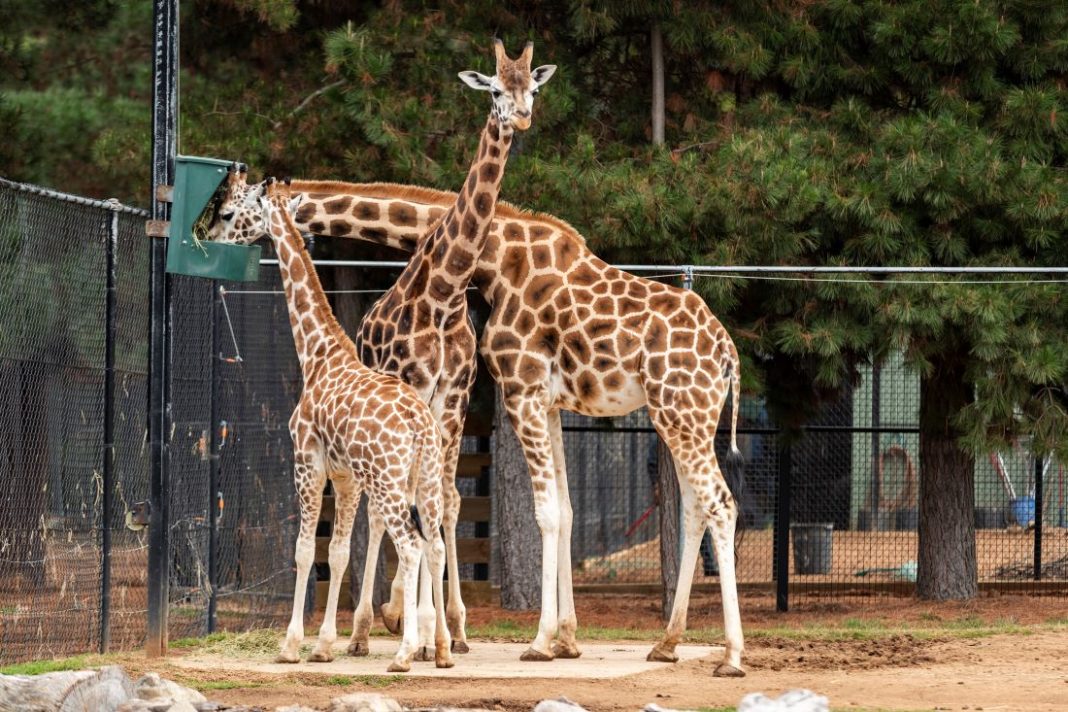Giraffes have a hard start to life, falling 2 metres to the ground and breaking their amniotic sack which helps them start to breathe. Life hasn’t gotten much easier for them; losing almost 90 per cent of their habitat in the last 300 years has left the giraffe population vulnerable to extinction. There is only an estimated 117,000 giraffes alive in Africa today.
“That sounds like a large number but it’s about a third of the size of the African elephant population to put it into perspective,” says National Zoo and Aquarium wildlife supervisor Sophie Dentrinos.
21 June marks World Giraffe Day (WGD). Celebrating its 10th anniversary, WGD was created by the Giraffe Conservation Foundation (GCF) in 2014 to celebrate the tallest animal as well as educate and spread awareness on the challenges giraffes face in the wild. Held on winter solstice, the longest day in the northern hemisphere and the longest night in the southern hemisphere. It is the perfect day to celebrate the animal with the longest neck.
To help celebrate, the National Zoo and Aquarium are hosting a special “paint and feed” event this Sunday 23 June. The day will start with a giraffe talk, guests will get to paint a customised picture of one of the Zoo’s giraffes, developed by Paint and Pinot. Guests will then have the opportunity to feed a giraffe.
The Zoo holds a giraffe talk at 2pm every day, including Friday 21 June where you can hear about WGD and see the giraffes getting their lunch feed.
“We’ll spoil the giraffes by giving them lots of extra enrichment.” Ms Dentrinos promised.

The National Zoo and Aquarium is home to a total of six giraffes, including breeding pair Shaba and Mzungu, who are housed with two of their beautiful children: two-year-old Themba and the newest calf, eight-month-old Mkali. The family unit also shares their enclosure with a herd of Indian Blackbuck.
“It’s very common to see giraffes with animals like zebras and eland,” says Ms Dentrinos
Due to their amazing eyesight, seeing up to 20km, Giraffes are able to spot predators coming early, acting as a warning signal for the smaller prey species.
Non-breeding pair Skye and Khamisi share the African plains enclosure, which is attached to the Jamala Wildlife Lodge accommodations, allowing guests the opportunity to overlook their night yard and have them visit your balcony.
Dad-Shaba and Mum-Mzungu came to the Zoo as part of the breeding program in 2015 from Mogo and Taronga respectively. They’ve been with the Zoo for nine years and have been actively breeding for the past eight. They are taking a much-needed break from breeding at the moment after welcoming their fifth calf in September.
“As a region, every zoo holds their animals, then we have someone who looks at the genetics of all those animals and decides which ones would be best suited to breed with and for how long. We don’t want to continuously breed from the same line over and over, we want to be able to add into that genetic diversity where we can.” Ms Dentrinos explains.
New genetic research through the GCF has yielded theories that contrary to former belief there are four distinct species of giraffe instead of just one: Northern giraffe, Southern giraffe, Reticulated giraffe and Masai giraffe.
“It means that protecting the genetic pools is even more important these days, we’re looking at much smaller numbers within those four species. So, as our role here at National Zoo, we very much enjoy highlighting giraffes on June 21 every year,” explains Ms Dentrinos.
Canberra Daily is keen to hear from you about a story idea in the Canberra and surrounding region. Click here to submit a news tip.



